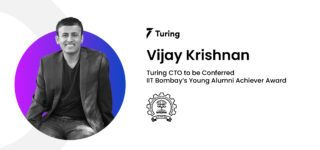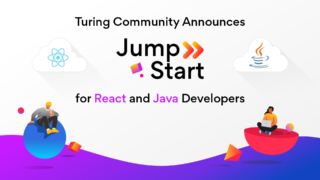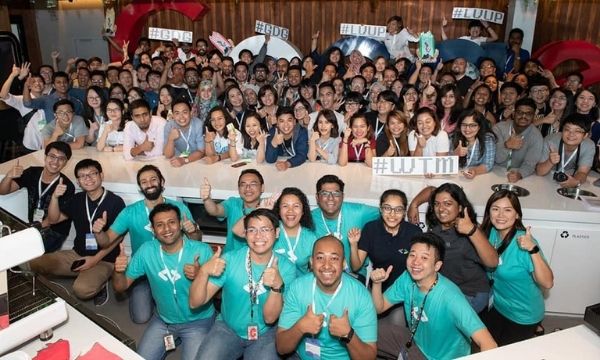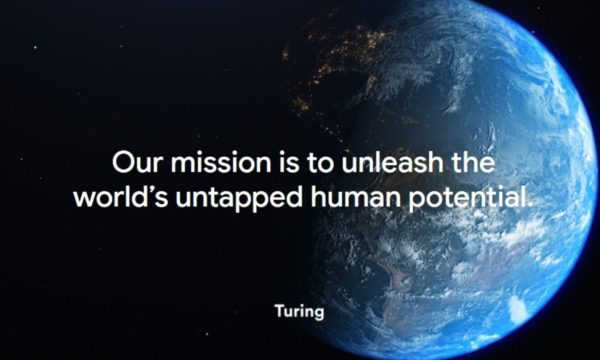Turing Founder and CTO shares how the advantages of AI can simplify the recruitment process for technical leaders and engineering managers.
In the first edition of Turing Boundaryless Podcast, Turing Founder and CTO, Vijay Krishnan, digs deeper into the remote recruitment process and how AI could aid it. He also answers questions on building high-performing distributed teams.
Krishna Vinod
Welcome to the first edition of the Turing Boundaryless Podcast. I’m your host, Krishna Vinod, Social Media Head at Turing. Today, we’re conversing with Vijay Krishnan, Founder and CTO of Turing.com, headquartered in Palo Alto, California, right in the heart of Silicon Valley.
Vijay has worked in ML and AI for over 18 years in academia and industry. Today, we will be discussing the $1 trillion problem of matching talent with opportunity and how AI could help solve it. Vijay, please tell us more about your story and how you reached this point in your career—founding and leading technology for Turing.
Vijay Krishnan
Thank you, Krishna. I have been working in the field of AI and ML for almost 18 years now. So, my TLDR would be: “machine learning researcher turned 2x AI entrepreneur,” maybe that’s the one-line version of it.
I started back in my bachelor days at IIT Bombay, where I studied computer science. I wrote some papers on the problems of text categorization, web search, and web spam detection.
I did that both at IIT Bombay and Stanford University and even when I was a scientist at Yahoo in the Bay area. My previous company made personalized content recommendations. So, what we did in our earlier startup was to discern people’s interests based on the content they consumed.
So we would build a very detailed profile of users and use that information to recommend other content they may like. So this, of course, involved a lot of deep user profiling and various problems like that. Our company got acquired by Revcontent, an ad-tech company where I briefly served as SVP of data science. At Turing, I run a lot of our AI and data science efforts related to data science for various classic business problems and the exciting problem of matching talent with opportunities at a global scale.
Krishna Vinod
Awesome. That is a fantastic introduction. What are typical things that go wrong in a distributed team, and how should one mitigate them?
Vijay Krishnan
Yeah, great question Krishna. Your question also speaks of why remotely distributed teams didn’t happen earlier. It seems completely crazy to restrict your talent pool to a 10-mile radius around your offices when you could hire from the whole world.
But obviously, the world did not opt to move in this direction. And it is primarily because of a lot of factors. The big-ticket item is just that teams found it very difficult to hire at a global scale effectively. Well, and when I say hire, even that has different parts:
- How do you effectively source talent on a worldwide scale?
- How do you effectively screen and vet talent at a global scale so that you ultimately have an excellent pool of talent to work with within your team?
- And how do you make sure that the collaboration itself is effective?
One prevalent complaint I heard from engineering leaders in the Silicon Valley used to be something like this: “You know, I know it is less competitive and cost-effective, and I can hire in other parts of the world, but in the limited experience I’ve had, three people or five people in a remote location end up producing the same real value for me that one strong engineer in my office would do. So, consequently, what looks attractive at first glance does not turn into the value I was expecting of it.”
So why does remote work not generate value under these circumstances? I think a big part of it is Point Number One and Two.
A lot of companies build a strong intuition regarding how to source in their local environment. But when it comes to collaboration, one has to be very deliberate about making that collaboration effective. In a local office, one does not need to think about this question very much. You see your developers daily. You can assume that they will mingle with others and develop more organizational context over time. Ultimately you want to replicate the same sorts of collaboration, value, and context that a person in your office would have.
We have found some practices to be very good in this regard. One is time zone overlap. So at Turing, when any of our partner companies in the Bay area or the rest of the US, for the most part, hire one of our software developers, we always ensure that a software developer can at least overlap up to four hours or more with the company’s regular workday.
This overlap is vital because without having enough opportunity to unblock, you run into many inefficiencies coming from pure miscommunication, partial context, and so on. But again, our experience has shown that something like four hours turns out to be very good and is almost as good as a full day’s worth of overlap.
Another thing we have seen to be vital is the effective use of video. When you are doing these kinds of cross-border video calls, reliable video calls become essential. Unfortunately, I still see so many companies where people do Zoom calls where everyone has their video off, and nobody builds any connection with anybody else. And such a thing is, of course, a disaster for collaboration.
Another vital thing is to have a process that nudges your remote team members toward over-communication. So there’s a particular ‘pass-it-on personality type that can function reasonably well in an office setting. Unfortunately, that requires some change in this all-remote world. One needs to over-communicate. A company needs to have a process to ensure that people talk with many other loosely related stakeholders and build a one-on-one connection with them over a video call.
Krishna Vinod
Great points, Vijay. Talking about culture, are there any points that you would like to add about building a unified company culture?
Vijay Krishnan
Yeah, sure! Today, I don’t think companies pay enough attention to specific soft skills in the interviewing process. Instead, they do a certain amount of technical interviewing and nebulous culture-fit interviews.
In most cases, I don’t think they even have a precise notion of what they are looking for when they say culture-fit. So to make remote working more effective is a two-part thing.
First: Technical leaders should interview for a lot of soft skills that become crucial to remote work.
And that should be an important part of the hiring equation itself.
It is essential to test how good a person’s communication skills are. And when I say communication, I don’t just mean English fluency. I also mean matters to do with the ownership. Issues to do with being able to navigate ambiguity effectively. Whether a person is proactive enough to reach out to many different people in the organization to get certain things done, or if the person is relatively passive.
Second: It is crucial to gauge whether a person can think in the objective or company scope, more broadly than merely the task scope. Going forward, this should be treated as a very vital hiring signal. Paying attention to the whole onboarding process is also crucial.
Additionally, there is ample room for something like virtual mixers. I’m looking forward to a product, which looks like the modern equivalent of the old-school chatroom. However, applied within a corporate context, people get a chance to be in a virtual party-like sense allowing people to mingle with others in different parts of the organization that they might not associate with generally. This type of association is vital to gaining a broader organizational context and becoming more effective. It also makes people feel more connected and prevents them from burning out.
Krishna Vinod
Excellent. Very, very valid points, Vijay. Now coming to AI and ML, you have a ton of experience. How do you feel the industry has evolved over the years? And, what is your advice for the future for companies and developers who wish to realize value with AI?
Vijay Krishnan
Yeah, great question, Krishna! I’m listening to Kai-Fu Lee’s audiobook. I would recommend that to everyone. It’s called ‘AI superpowers,’ and it’s pretty interesting. So when I started in AI and ML, they could do quite well for email spam classification and a bunch of other problems.
But, this reboot of the neural networks via this deep learning revolution, if you will, in 2012, 2013 has sparked a lot of new interest in machine learning and opened up many new avenues. During my grad school at Stanford, neural networks promised a lot but didn’t do much compared to alternate methods.
With time, a number of the previous stumbling blocks got solved. Of course, all the other developments helped, like increased computing power, our ability to deal with non-convexity, etc. Despite this, the state of our understanding was still nebulous.
To be fair, even today, many statisticians would still consider our understanding of why deep learning works so well to be quite nebulous.
Today, the best I suspect we can do with deep learning is if it works exceedingly well, but we cannot prove any mathematical properties about it. But the fact is, yeah, there is no question that there were so many intractable problems with image understanding, video understanding, speech to text. I remember how primitive a lot of our machine translation methods were between languages and all that.
Effectively earning nonlinearities like this by deep learning has opened up a new range of problems and possibilities. These things have a lot of feedback loop effects. Once the world realized that this could be such a massive game changer and produce billions or trillions of value over time, that led to many feedback loop effects.
Nvidia, formerly a gaming chips company, suddenly became more valuable as people started using GPUs for deep learning. Then, of course, Google, Facebook, and so many others began thinking of themselves as the AI-first companies engaged in massive investments in these areas, which enabled us to realize the potential in these specific areas.
I do not doubt that we will continue to realize many advantages of AI and ML in the coming years.
So today, there’s this very simplified narrative, which I suspect many developers and even companies buy into. The narrative is that all the machine learning methods have become commodities, and AI can behave like a magic wand. And so, you don’t need any high level of competence as a software developer to get there.
And now you think all you need is a lot of data and some regular software developers to start producing cutting-edge AI technology. I believe this couldn’t be farther from the truth.
[With ML] Your degrees of freedom are just very high, and it is very limiting if you, as a developer or company, don’t understand the underlying mathematics and your choices. It is rarely like a simple challenge on Kaggle—this popular website that does these data science competitions—where your problem is very bounded. They give you a dataset. Everyone already knows that one of these five or ten methods will work. Maybe there’s some minor tweaking you can do. And virtually almost everyone gets the best result. But that is not how real-world machine learning goes. There are just too many degrees of freedom in a bunch of different spaces.
The other thing is certainly your various choices of modeling options. What do you do? Do you choose to get more data labeled? What would be the likely impact of various things? Again, I think not understanding the underlying mathematics gets you very crippled under that circumstance.
It is important to go deeper into mathematics and look at it from a 20,000 feet level. I see many industry machine learning efforts where these two things don’t get done adequately, and the technical leaders suddenly realize they are falling behind. They have to invest a lot in AI. They build out teams, but they fail in these two key areas. And consequently, they have wasted efforts and failed projects.
Krishna Vinod
Awesome. That is quite insightful, Vijay. So, now I have a follow-up question: What are some use cases and advantages of AI and ML at Turing. And, what does the future hold for AI and ML applications at Turing?
Vijay Krishnan
Good question. So, first of all, we are an obsessively data-driven company.
Our ratio of data scientists to software engineers is something like one to two, which, I think, would be unusually high here based on what most companies do. I believe in most companies, for every 20 software engineers, they may have one data scientist.
I would split Turing’s machine learning and data science activities into two parts. The first would be business analytics type of use cases.
However, a big chunk of our efforts goes into evaluating software developers, better profiling software developers, and matching software developers. I’m sure many people have heard companies talking about precisely this in the context of the resume matching to jobs, for example.
However, at Turing, it goes a lot deeper than this because the resume is a tiny piece of the signal for us. Instead, we rely heavily on developers’ performance in our various tests. This process tells us about the developers, strengths, past projects on Turing with multiple customers of ours, etc.
Here, we have a lot of data regarding what predicts success and what is a waste of time and doesn’t give us much. Since, when we are trying to build a compelling profile of a developer, we are trying to ask the simple question: “How do I make every minute count. How do I make sure I don’t waste the software developers’ time, and every minute I spend assessing them gives me some very material information about them?”
Many people’s initial reaction is to think about Turing’s matching and ranking problem as similar to a Facebook or feed ranking problem or a Google search ranking problem. But it is not quite the same thing because the value of generating one specific, good feed ranking is not very high.
In Turing’s case, this is not entirely true. Here, we are engaging in an activity, which is at least, I would say, conservatively somewhere between a hundred thousand to a million times as valuable as one feed ranking on Google or Facebook.
The economic impact of putting the right developer in front of the right job and the resulting value that a company can realize over the coming year or 18 months is very, very high.
So, in a sense, our matching system serves as a ranking system and a sort of GPS for people in our operations team to tell them precisely what new information we need to collect and from whom to make a more informed decision.
Krishna Vinod
That was insightful, Vijay. So, now, really coming to the question that everyone’s been waiting for. What is your take on the $1 trillion problem of matching talent with opportunity, and how do you feel the advantages of AI could help solve it?
Vijay Krishnan
Yeah, I think the recruitment process becomes particularly more complex in this remote-first world.
So in the old world, if you will, where all hiring was local, arguably the problem itself is less complicated. And, while AI and ML could help improve things somewhat, the opportunity is just not as big.
Let’s take the old-school recruitment process where technical leaders in Palo Alto wish to hire a full stack developer with Node and React expertise within a five or 10-mile radius of Palo Alto. Now, this automatically shrinks the pool down to the people with those specific skills, who live within the particular area, and who are also available/ interested in the specific job, which invariably ends up being a relatively small pool at any given point in time.
In areas like Silicon Valley, it ends up being the case. Not because there are not enough developers, but because it’s a tight labor market. So, if you have ten candidates to choose from, there’s not a ton that AI and ML can do at that point. On the flip side, if there is one software company within a ten or a twenty-mile radius of where developers live, their interests or ideal job don’t matter. Similarly, if there’s one software company within a five to ten miles radius, that is where people are probably working, and AI and ML can’t do a ton for you.
But the recruitment process completely changes in this remote first-world. Today at Turing, we have software developers from more than 10,000 cities across 140 countries worldwide. Once you relax these location constraints, that changes the game completely.
At Turing, there are possibly between 10,000 to 50,000 possible developers we could match for that specific job for every job opening. This statistic is for an average job. Of course, there are particular jobs with rare skills. But again, given the large size of our developer pool, more than 700,000 strong, there’s always a very, very sizable number of developers there. And on the flip side, there are hundreds of jobs they could be matched to in any given month for each developer.
So, here, the novel opportunity in the recruitment process comes because we generate certain kinds of win-win outcomes that the world has never seen before. The whole idea is about maximizing the extent to which work translates into value.
Krishna Vinod
That’s amazing. So what I’m getting is that with the help of AI, we can turn this trillion-dollar opportunity into a win-win for both developers and customers?
Vijay Krishnan
That’s exactly right. We have seen how much value a company can unlock due to increasing the sphere of effective collaboration itself.
I’ve read certain economic writings that talk about the early 20th century and the impact of the automobile on increasing the radius of people’s job opportunities. When the radius of job opportunities expanded from two to twenty miles, it was a game-changer. But now, imagine expanding the area by a factor of a hundred. Presumably, such a thing would increase job opportunities 100X. Now, consider what happens when you grow that to the diameter of the planet? So, yes, absolutely.
Krishna Vinod
Awesome. So now, coming to the final question, Vijay. What does the future hold for Turing as a company, and how will AI help shape that future?
Vijay Krishnan
Right. So people think specifically about Turing’s rise amidst the pandemic. But the fact of the matter was that we were growing very rapidly, even pre-pandemic. The pure talent shortage in the recruitment process, economic pressures, and the high cost of living in various urban areas were nudging the world in this direction, but probably, not as fast as the pandemic did.
Ultimately, even in a post-pandemic world, boundaryless teams will make for a happier and healthier society with a lower carbon footprint where people do what they love.
Ask your grandparents if they loved their jobs. They would probably say no. The purpose of a job is to earn money, which was the case with most of society. Now, a more significant percentage of people are in jobs that they love. Imagine extending that to the world itself. It’s also inspiring to create a level playing field for our talented software developers all over the world and give them the same exposure and the opportunity to work on projects of the same complexity as their Silicon Valley counterparts. These opportunities eventually allow them to grow much like their Silicon Valley counterparts.
The biggest bottleneck to technology advancement today is the shortage of talented software developers. So, at Turing, it is exhilarating to be at the forefront of both—helping technology advance a lot faster than it would have otherwise and exposing the world’s software developers to the most exciting opportunities there are.
Krishna Vinod
Amazing. Thanks, Vijay. That was very insightful and a great discussion overall.
Watch the complete video.
Tell us the skills you need and we'll find the best developer for you in days, not weeks.
Hire Developers



















